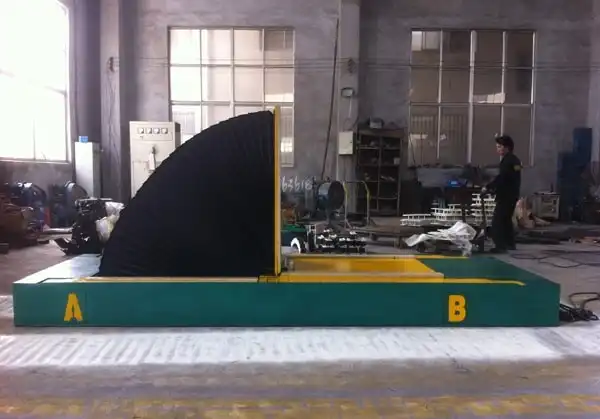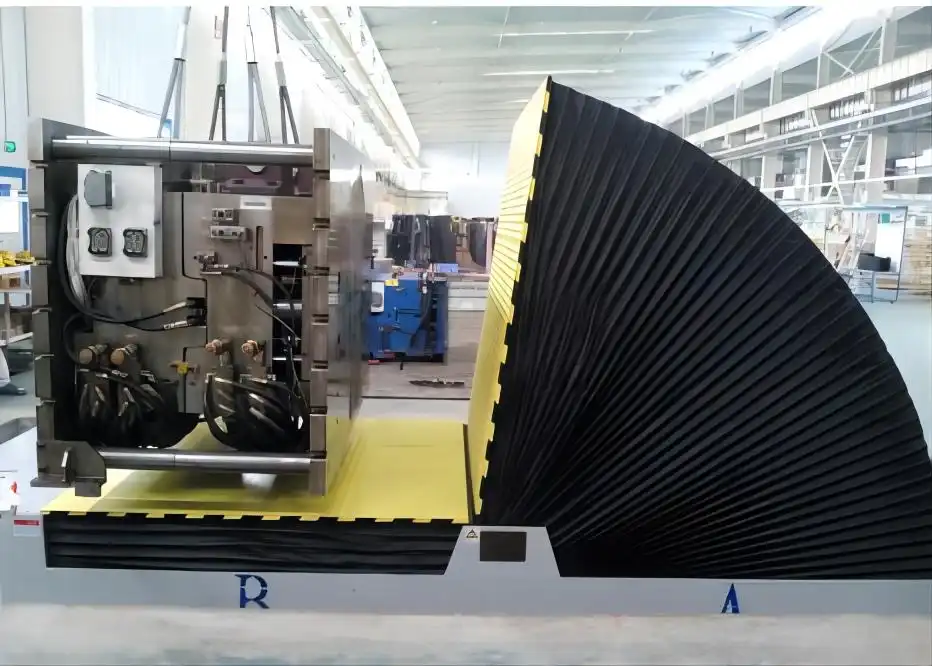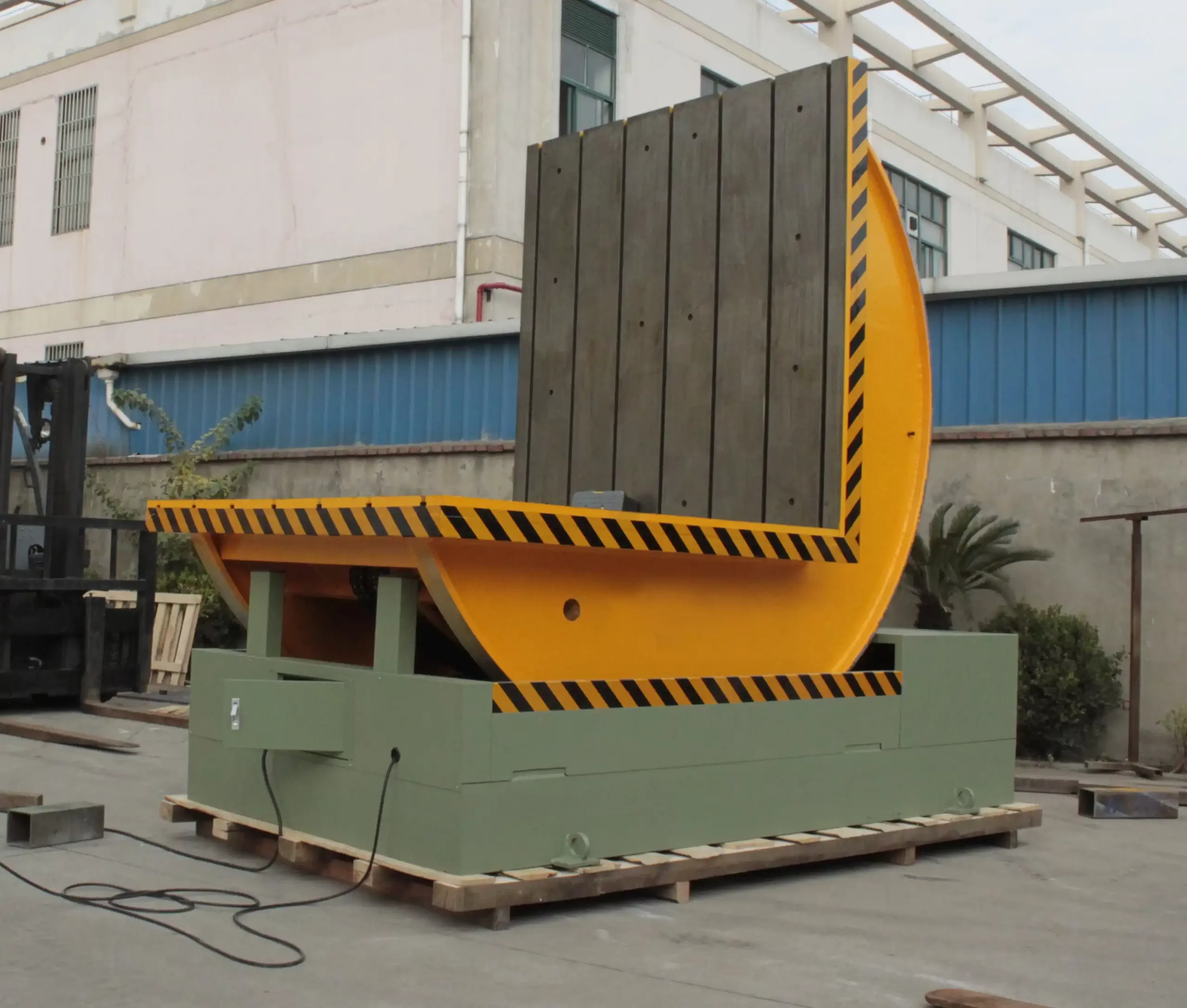Are you spending too much time and taking too many risks during mold and die changeovers? In many Argentine factories, the process of flipping heavy molds with cranes or forklifts is a major bottleneck. It's slow, requires multiple operators, and creates a constant risk of accidents. This inefficiency eats into your production time. A single slip can lead to catastrophic damage to a mold that costs tens of thousands of dollars, not to mention the potential for serious worker injury. This situation keeps many plant managers awake at night, worried about safety, downtime, and spiraling costs. The good news is that a growing number of forward-thinking manufacturers in Argentina are finding a better way by investing in a specialized piece of equipment: the hydraulic mold upender.
Argentine manufacturers are increasingly investing in hydraulic mold upenders primarily for three reasons: a dramatic increase in workplace safety, a significant boost in operational efficiency, and superior protection for their valuable molds and dies. This equipment provides a controlled, stable, and fast method for turning heavy loads, directly solving the core problems of slow, hazardous, and expensive traditional handling methods. By moving this critical task from an unpredictable crane lift to a predictable machine process, factories can reduce risks, cut down on changeover times, and ultimately improve their bottom line.

This shift isn't just a trend; it's a strategic business decision. As an engineer who has spent his entire career on factory floors, I've seen firsthand how a single piece of equipment can change everything. It’s about more than just a new machine. It's about creating a safer environment for your people and a more streamlined process for your entire operation. Let’s dive deeper into the specific reasons why this investment makes so much sense for manufacturers across Argentina, from Buenos Aires to Córdoba. We will look at how it impacts safety, the real return on investment, and its effect on your overall production flow.
How Do Hydraulic Upenders Directly Impact Operational Safety?
On any factory floor, the sound of a crane lifting a multi-ton mold is a moment of high tension. Everyone in the vicinity is aware of the potential danger. Are the straps secure? Is the load balanced? A single miscalculation or equipment failure can lead to a devastating accident. This isn't just a hypothetical problem; it's a real-world risk that results in injuries, damaged equipment, and costly production shutdowns. The liability and the potential harm to your team are immense. This is why many Argentine companies are actively seeking to engineer this risk out of their processes. The solution they are turning to is the hydraulic upender, which provides a controlled, ground-level method for turning heavy loads safely and predictably.
Hydraulic upenders directly impact operational safety by replacing the unstable dynamics of overhead lifting with a secure, machine-controlled rotation. The equipment firmly holds the mold on a stable platform and uses smooth hydraulic power to turn it 90 degrees. This process minimizes the primary risks associated with traditional methods, such as dropped loads, swinging cargo, and the need for operators to work in close proximity to a suspended, heavy object. It transforms a high-risk manual task into a safe, automated procedure.

Deconstructing the Safety Advantages
To fully appreciate the safety improvements, it's important to compare the old way with the new way. Traditional methods are filled with variables, and every variable is a potential point of failure.
The Inherent Risks of Traditional Mold Handling
When you use an overhead crane or a pair of forklifts to flip a mold, you introduce several dangers. First, there's the risk of load failure. Chains, straps, or slings can break under stress, especially if they are worn or improperly attached. Second, achieving a perfect center of gravity is difficult. An unbalanced load can swing unexpectedly or slip from its rigging during the turn. Third, operators often need to be close to the load to guide it, placing them in a hazardous zone where they could be struck or crushed. I once visited a factory where a near-miss occurred; a strap slipped, and a five-ton die shifted violently, missing a worker by inches. The incident shut down work for hours while everyone recovered from the shock. These events are far too common.
The Safety-by-Design of a Hydraulic Upender
A hydraulic upender is engineered specifically to eliminate these risks. Its design is based on stability and control.
- Stable Platform: The mold rests on a wide, stable base, not suspended in the air. This immediately removes the risk of a fall.
- Secure Clamping: The machine often has features to secure the load to its two platforms before rotation begins.
- Controlled Movement: Hydraulic systems provide smooth, judder-free power. The rotation speed is constant and predictable, with no sudden jerks or shifts.
- Remote Operation: The operator typically stands at a control panel, well away from the machine's moving parts. This removes them from the immediate danger zone.
Here is a simple breakdown of the risk comparison:
| Risk Factor | Traditional Method (Crane/Forklift) | Hydraulic Upender Mitigation |
|---|---|---|
| Dropped Load | High risk due to potential rigging failure or imbalance. | Virtually zero. Load is secured to a stable, rotating platform. |
| Operator Proximity | High. Operators must be close to rig and guide the load. | Low. Operator uses a remote console from a safe distance. |
| Control Precision | Low. Relies on operator skill; susceptible to swinging/jerking. | High. Smooth, consistent, and predictable hydraulic movement. |
| Equipment Stress | High. Concentrated stress on lifting points of the mold. | Low. Load is supported across a large surface area, reducing stress. |
This clear reduction in risk is a primary driver for the adoption of upenders in Argentina's safety-conscious manufacturing sector.
What Is the Real ROI of a Hydraulic Mold Upender Beyond the Initial Cost?
As a business owner, every major purchase must be justified. It's easy to look at the price tag of a new hydraulic upender and see it only as a significant expense. But focusing solely on the initial cost is a mistake. The alternative—sticking with older, less efficient methods—comes with its own set of hidden and ongoing costs. You pay for it in slow changeovers, which means lost production. You pay for it in the occasional but very expensive damage to a mold or die. And you pay for it in higher insurance risks and the potential for costly accidents. A pragmatic entrepreneur, however, looks for the solution that delivers the best long-term value.
The real return on investment (ROI) of a hydraulic mold upender comes from a combination of direct cost savings and efficiency gains that far outweigh the initial purchase price. These benefits include a dramatic reduction in labor hours for each mold change, the prevention of costly damage to essential tools, lower insurance premiums due to a safer working environment, and a significant increase in valuable production uptime. It’s an investment that pays for itself by systematically cutting hidden operational costs.

Breaking Down the Financial Returns
Let's move beyond generalities and look at the specific financial benefits. A factory owner needs to see the numbers to believe it.
Quantifying Time and Labor Savings
A typical mold change using a crane can be a complex, time-consuming task. It might require two or even three skilled operators: one to run the crane and others to manage the rigging and guide the load. The process can easily take 45 to 90 minutes. In contrast, a hydraulic upender can be operated by a single person. The process is straightforward: place the mold, press a button, and retrieve it a few minutes later. The entire operation can be completed in under 15 minutes.
Consider a plant in Argentina that performs three mold changes per day.
- Traditional Method: 3 changes/day 60 min/change 2 operators = 360 labor-minutes
- With Upender: 3 changes/day 15 min/change 1 operator = 45 labor-minutes
That's a savings of 315 labor-minutes, or over 5 hours, every single day. Over a year, this translates into thousands of hours of saved labor that can be reallocated to more productive tasks.
The High Cost of a Damaged Mold
Molds and dies are not simple pieces of metal; they are precision-engineered tools that can cost anywhere from $20,000 to over $200,000. When a mold is turned improperly with a crane, the focused stress on the lifting points can cause warping or micro-fractures. A dropped mold is often damaged beyond repair. A hydraulic upender supports the mold across its entire surface, distributing the weight evenly and eliminating these stress points. Preventing just one instance of mold damage can often pay for the entire upender.
Here is a simplified ROI calculation to illustrate the point:
| Financial Factor | Example Annual Value | Notes |
|---|---|---|
| Labor Savings | $25,000 | Based on 5 saved hours/day at a conservative labor rate. |
| Mold Damage Prevention | $30,000 | Assumes preventing one minor repair and a fraction of a full replacement cost per year. |
| Increased Uptime Value | $40,000 | Gaining 7.5 hours of production time per week from faster changeovers. |
| Total Annual Return | $95,000 | |
| Initial Investment | -$70,000 | Example cost of a mid-size hydraulic upender. |
| Payback Period | ~9 months | The time it takes for the machine to pay for itself. |
This table shows that the upender is not a cost center; it is a profit-generating asset. This is the kind of analysis that convinces practical business leaders in Argentina to make the investment.
Can Integrating an Upender Improve Overall Production Flow?
Every factory manager knows the pain of a production bottleneck. It's that one slow station that holds everything else up, causing machines to sit idle and schedules to fall behind. Often, in stamping, injection molding, or forging operations, the mold changeover process is a primary culprit. It's a necessary but time-consuming interruption. This disruption directly impacts your plant's overall equipment effectiveness (OEE) and makes it difficult to respond quickly to changing customer demands. To stay competitive, Argentine manufacturers need a smooth, predictable, and fast-flowing production line.
Yes, integrating a hydraulic upender absolutely improves the overall production flow by transforming a slow, variable bottleneck into a fast, standardized process. By drastically cutting down mold turning time, it shortens the entire changeover window. This reduction in downtime means more time is spent actually producing goods. It allows for more precise production scheduling and helps create a more agile and responsive manufacturing environment, directly contributing to higher capacity utilization.

From Standstill to Streamlined
The impact of an upender goes beyond just the machine itself. It has a ripple effect throughout the factory's workflow and planning systems.
Eliminating the Changeover Bottleneck
Without an upender, the press or molding machine is tied up for the entire duration of the mold change, including the slow and careful process of turning the mold. The main production asset is non-productive. When you introduce a hydraulic upender, you can create a dedicated, offline mold preparation area. While one mold is running in the press, the next mold can be brought to the upender, turned, and prepared for installation. When it's time for the changeover, the prepared mold is ready to go. The time the press is down is reduced to simply swapping the molds, not waiting for one to be slowly flipped by a crane. This principle of "externalizing" setup tasks is a cornerstone of lean manufacturing, and the upender is a perfect tool to achieve it.
Enabling Predictable and Agile Scheduling
When your changeover time can vary from 45 minutes to 2 hours depending on which crew is on duty or how complex the rigging is, production scheduling becomes a guessing game. You have to build in large buffers, which reduces efficiency. A hydraulic upender standardizes the process. A 90-degree turn takes the same amount of time, every time. This predictability is golden for production planners. They can schedule changeovers with confidence, enabling smaller batch sizes and a more Just-in-Time (JIT) approach to manufacturing. This agility is a huge competitive advantage in Argentina's dynamic market, allowing factories to quickly switch between different products to meet fluctuating demand.
I worked with a client in Santa Fe whose stamping plant was struggling with long changeovers. They produced parts for the agricultural and automotive sectors, and demand was volatile. After installing a mold upender, they reduced their average changeover time from 75 minutes to just 20 minutes. This newfound speed allowed them to accept smaller, more frequent orders from clients, which they previously had to turn down. Their production flow became smoother, and their business grew as a result.
My Insights: Why This Is a Strategic Move, Not Just an Equipment Purchase
Over the years, I've sold and installed countless machines. I’ve seen factory owners who view equipment as just a tool to perform a task. They look at specs, they look at price, and they make a decision. But I’ve also worked with leaders who see things differently. They understand that the right piece of equipment can be a catalyst for something much bigger. It can change the way people work, shift the culture of a facility, and lay the groundwork for future growth.
From my perspective as both an engineer and a factory founder, buying a hydraulic upender falls into this second category. It is not just another purchase order. Investing in a hydraulic mold upender is a strategic move because it sends a powerful message about your company's commitment to safety and efficiency, which boosts morale and productivity. It forces a re-evaluation of your entire workflow, often sparking further process improvements. More importantly, it serves as a foundational step in modernizing your factory floor, building the confidence and momentum needed for a broader digital transformation.

A Catalyst for Cultural and Process Change
Let's look beyond the steel and hydraulics and consider the human element, which is where the real long-term value is created.
Building a Culture of Safety and Respect
Your employees are your most valuable asset. When they see management investing in equipment that makes their job demonstrably safer, it sends a clear message: "We value you, and we care about your well-being." Flipping a multi-ton mold with a crane is a stressful task. Removing that stress and risk builds trust and improves morale. A worker who feels safe and respected is more focused, more engaged, and more productive. This investment in safety is an investment in your people, and it pays dividends in loyalty, lower turnover, and a more positive work environment. This cultural shift is priceless.
The First Step on the Automation Journey
For many traditional manufacturers in Argentina, the idea of "digital transformation" or "Industry 4.0" can seem overwhelming and abstract. Where do you even begin? A hydraulic upender is a perfect starting point. It is a simple, standalone piece of automation with a clear and immediate benefit. It's easy to implement and its success is easy to measure. When your team sees how this one machine improves safety and efficiency, it demystifies automation. It builds confidence and creates an appetite for more. The success of the upender project can be the springboard for exploring other technologies, like automated guided vehicles (AGVs) to transport molds or IoT sensors to monitor machine health. It makes modernization feel achievable.
Early in my career, I was advising a factory owner who was hesitating on this exact purchase. He saw it as an expense he could put off. Three months later, a crane accident badly damaged a critical production die. The cost of the emergency repairs and the lost production was nearly four times the price of the upender. That lesson has stayed with me my entire life. It taught me that the real cost is often the cost of inaction. This is the core reason I founded SHJLPACK—to share these hard-won insights and help others make the strategic choices that lead to long-term success.
Conclusion
For Argentine manufacturers, investing in a hydraulic mold upender is a clear and logical decision. It is a powerful tool for enhancing safety, improving operational efficiency, and delivering a tangible return on investment.




